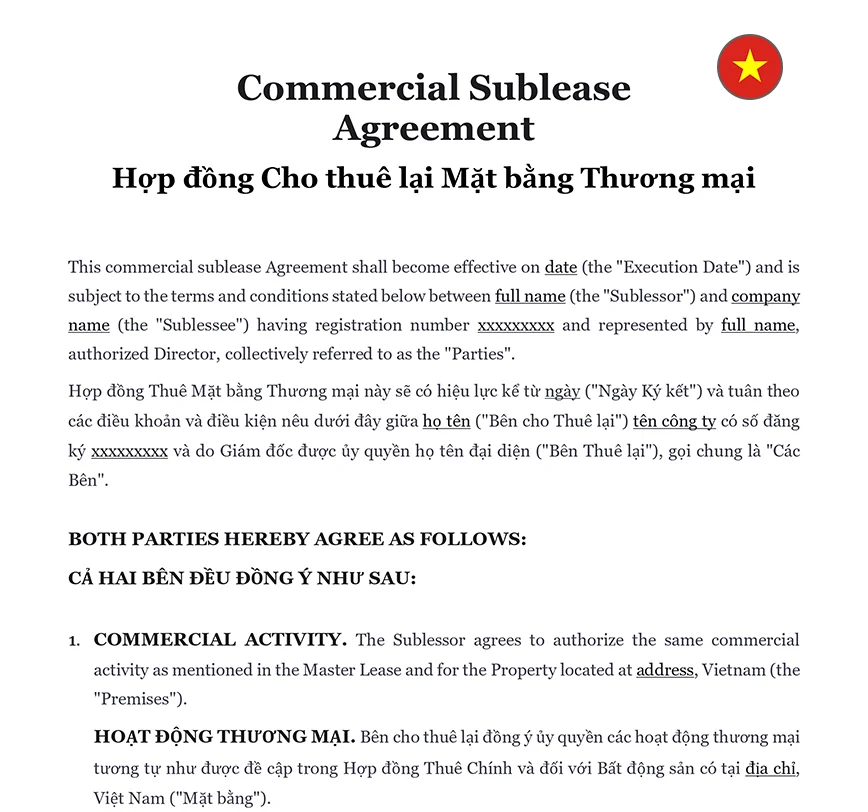Ready to use legal template
Drafted by experienced lawyers
Vietnamese-English translation
Ready to use legal template
Drafted by lawyers
Vietnamese-English translation
Home › Rent your property › Commercial sublease agreement
Learn more about Commercial Sublease Agreement in Vietnam
A Commercial Sublease Agreement offers a unique opportunity for businesses looking to maximize the use of their rented space. Themis Partner provides a Commercial Sublease Agreement drafted by experienced lawyers to ensure full compliance with the law in Vietnam. This comprehensive agreement is conveniently available in an easy-to-edit Word document format, allowing for seamless customization to suit specific subleasing arrangements. The contract grants the original renter the ability to sublet part or all of the property to another business, outlining key details such as rent amount, duration of the sublease, rules, restrictions, and the responsibilities of both parties.
Table of contents
What is a Commercial Sublease Agreement?
What is included in a Commercial Sublease Agreement?
Why would a business consider subleasing in Vietnam?
What are the landlords’ responsibilities in Vietnam?
What are the sublandlords’ responsibilities in Vietnam?
What are the subtenants’ responsibilities in Vietnam?
How are disputes handled in a Commercial Sublease Agreement?
What happens if the original lease ends before the sublease?
What is a Commercial Sublease Agreement?
A Commercial Sublease Agreement is a legal contract that allows a tenant renting a commercial property to lease all or part of that property to a subtenant. This arrangement occurs when the original tenant no longer needs the entire space or wants to share the cost of rent.
The original tenant retains their responsibilities under the original lease with the landlord but grants the subtenant certain rights to use the property for a specified period and under specific conditions. The sublease agreement outlines important details such as the rent amount, sublease duration, any rules or restrictions, and the responsibilities of both parties.
ℹ️ If you are looking for a Sublease Agreement, we kindly invite you to visit our dedicated page for residential sublease agreements. This will ensure you access the specific template tailored to your needs.
What is included in a Commercial Sublease Agreement?
A business sublet includes the following key elements:
| ➤ Parties: The names and contact information of the sublandlord (original tenant) and subtenant. |
| ➤ Property Details: A description of the commercial property being subleased, including the address and any specific areas or amenities included in the sublease.ty |
| ➤ Term: The start and end dates of the sublease. |
| ➤ Rent: The amount of rent to be paid by the subtenant, including the frequency of payments and any late fees. |
| ➤ Security Deposit: The amount of any security deposit required from the subtenant, along with the conditions for its return. |
| ➤ Utilities and Services: Clarification of which utilities and services are included in the rent and which are the responsibility of the subtenant. |
| ➤ Rules and Regulations: Any rules or regulations that the subtenant must follow, such as building rules or restrictions on use. |
| ➤ Maintenance and Repairs: Specification of who is responsible for maintenance and repairs of the property, including any obligations of the subtenant. |
| ➤ Insurance: Requirements for insurance coverage, such as liability insurance, and who is responsible for obtaining and maintaining the insurance. |
| ➤ Alterations and Improvements: Any restrictions or permissions regarding alterations or improvements to the property by the subtenant. |
| ➤ Default and Termination: Conditions under which the sublease can be terminated early by either party, as well as remedies for default. |




